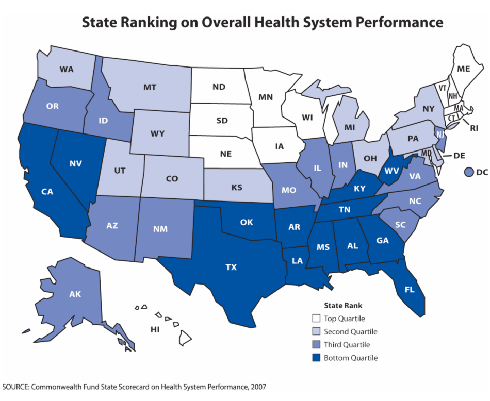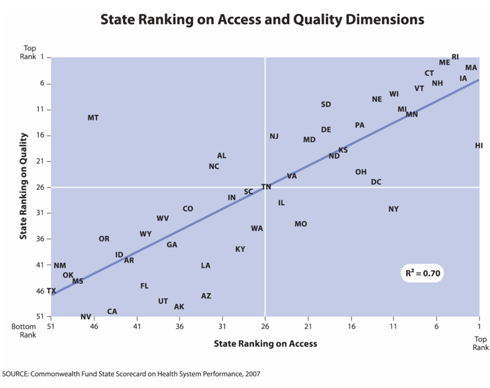Released June 13 by the Fund's Commission on a High Performance Health System at a packed Washington briefing attended by journalists, health care leaders, government officials, and others, the report, Aiming Higher: Results from a State Scorecard on Health System Performance, ranks states on 32 indicators of access, quality, avoidable hospital use and costs, equity, and "healthy lives." The report's authors include Joel C. Cantor and Dina Belloff of the Center for State Health Policy at Rutgers University and the Fund's Cathy Schoen, Sabrina K.H. How, and Douglas McCarthy.
While no state scored highly on each performance indicator, the health care system in certain states and regions is functioning markedly better than elsewhere. As shown in the map below (and in this interactive map), the Northeast and Upper Midwest rank high in multiple areas, while the lowest-ranked states are concentrated in the South. Hawaii, Iowa, New Hampshire, Vermont, and Maine top the overall rankings.
"The differences we found between the top and bottom states were shocking, often a two- to three-fold variation or greater," said Schoen. "Where you live clearly matters: for access to care when you need it, the quality of care you receive, and opportunities to live healthier lives." The report notes, however, that even the top states are not performing as well as they could be in certain areas.

One of the report's central findings is that across the country, access to health care and quality of care are highly correlated. States that provide residents with good access to care, particularly in terms of health insurance coverage, are also more likely to have higher-quality care. Four of the five states with the best access-to-care rankings—Massachusetts, Iowa, Rhode Island, and Maine—also rank among the highest on quality of care. States with low quality rankings tend to have high rates of uninsured residents.

In the five top-ranked states overall, nearly 90 percent of adults between ages 18 and 64 are insured. But in Nevada, Arkansas, Texas, Mississippi, and Oklahoma—the lowest-ranked statesonly 70 to 78 percent of working-age adults have health coverage. In states with low uninsured rates, adults and children alike are more likely to receive essential preventive services, to receive proper treatment for chronic illnesses, and to have an ongoing relationship with a health care provider.
These findings, the authors say, strongly suggest that expanding health insurance coverage is an important first step in ensuring that all patients get recommended care.
The analysis did not find that spending a lot on health care produces high-quality health care. Indeed, some states achieve high quality at relatively low costs. The states with the highest levels of spending tend to have higher rates of what the report terms "preventable hospital use," including patients who are admitted, or readmitted, to the hospital for diabetes, asthma, and other chronic illnesses that can be effectively treated in a primary care setting. The scorecard documented tremendous variability in potentially preventable hospital use: for example, the rate of children admitted to the hospital for asthma ranges from 55 per 100,000 in Vermont to 300 per 100,000 in South Carolina.
The authors of Aiming Higher illustrate the substantial human and economic gains to be had from improvements in health care access, quality, and efficiency. For example, if all states could attain the level of performance achieved in the top-ranked states in each category:
- There would be nearly 90,000 fewer deaths annually before age 75 from treatable health conditions.
- The uninsured population would be cut in half.
- Nearly 4 million more people with diabetes would receive basic recommended care, and 9 million adults age 50 or older would receive essential preventive care.
- Potentially preventable hospital admissions and readmissions could be reduced by 30 percent to 47 percent and save the Medicare program $2 billion to $5 billion each year.
"The scorecard tells us where we are. Now we need to decide where we're going," said Fund president Karen Davis. "Doing better is possible, but it will take commitment and action on all levels to achieve real change."